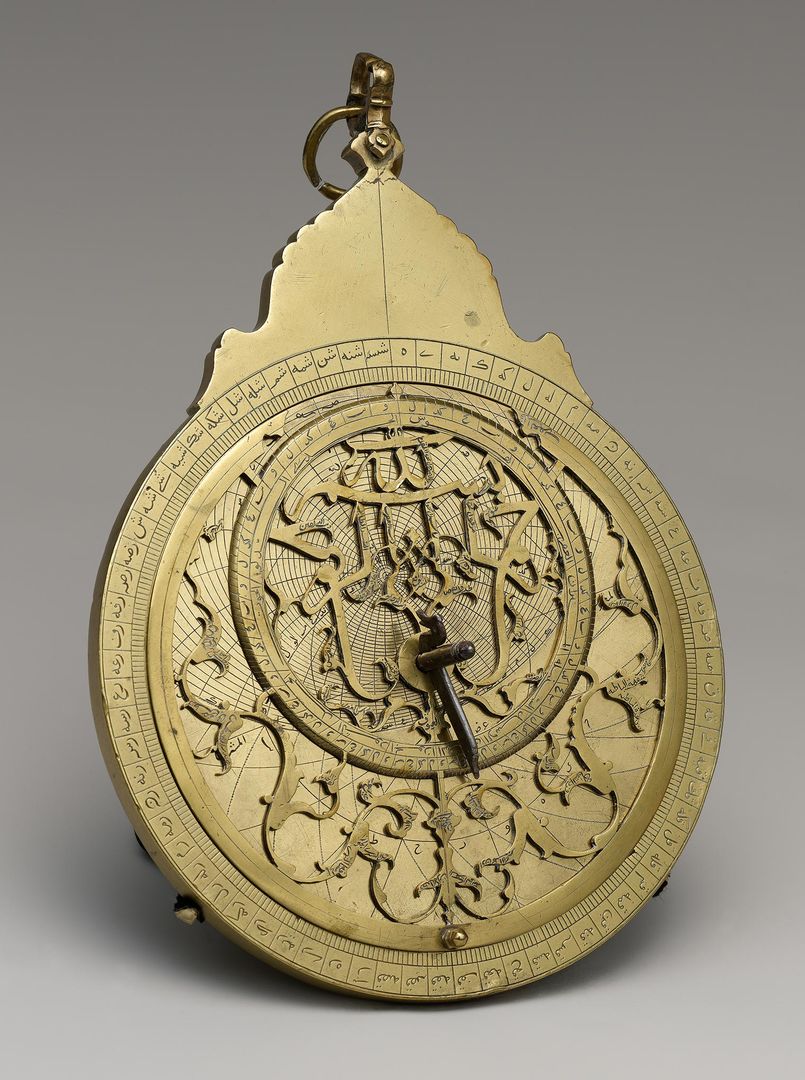Science and the Art of the Islamic World

Planispheric astrolabe, dated A.H. 1065 / A.D. 1654–55. Maker: Muhammad Zaman al-Munajjim al-Asturlabi (active 1643–89). Iran. Mashhad. Brass and steel, cast and hammered, pierced and engraved, 8 1/2 x 6 3/4 x 2 1/4 in. (21.6 x 17.1 x 5.7 cm). The Metropolitan Museum of Art, New York, Harris Brisbane Dick Fund, 1963 (63.166a–j)
Collection Area: Islamic Art
Subject Areas: Science, Visual Arts
Grades: Middle School, High School
Topic/Theme: Art and the Environment
Goals
Students will be able to:
- identify similarities and differences between scientific tools used now and long ago; and
- use research findings to support observations and interpretations.
National Learning Standards
Science
NS.9-12.5 Science and Technology
NS.9-12.6 Science in Personal and Social Perspectives
NS.9-12.7 History and Nature of Science
Visual Arts
NA-VA.K-12.6 Making Connections between Visual Arts and Other Disciplines
Common Core State Standard
English Language Arts
CCSS.ELA-Literacy.CCRA.R.7 Integrate and evaluate content presented in diverse formats and media, including visually and quantitatively, as well as in words.
Questions for Viewing
- Look closely at the featured work of art; note its individual pieces and the way they link to one another. How might the various parts move?
- Describe the markings that cover each surface and the forms that make up the screenlike panel that covers the face (the rete, the Latin word for "net"). What might these shapes and markings indicate?
- An astrolabe is a tool that performs a range of tasks that include telling time, identifying when the sun will rise and set, and locating celestial objects in the sky. What are some ways this information might be useful every day? In the Islamic world, astrolabes were often used to help find the direction of Mecca (qibla) and determine prayer times. In this example, the rete forms the bismillah, the opening phrase of most chapters of the Qur'an.
- What are some devices people use today to help with telling time, navigating the environment, and viewing distant objects?
Activity
Activity Setting: Classroom
Materials: Paper; pencil; research materials supporting investigations of an astrolabe, sundial, celestial globe, compass, water clock, and telescope; a computer and Internet access (ideal but not required)
Subject Area: Science
Duration: Approximately 60 minutes (longer if you plan to build and test models of each device)
Research the origin, function(s), and underlying principles of one of the following tools: astrolabe, sundial, compass, water clock, or telescope. Compare and contrast your findings with your peers. Discuss what functions or guiding principles, if any, the works share and how these devices might support daily life or scientific practice. If time permits, build and test a model of the device (see Resources below for links to relevant materials).
Reflect on the various tools used today to support tasks such as finding your way to a new place, telling time, and observing objects too far away or too small to see with the naked eye. What benefits might these devices offer? What limitations do they present? Why might some people view the creation of a digital watch or GPS navigation as "progress" while others challenge this idea? Watch the video Tom Wujec Demos the 13th-Century Astrolabe. In what ways does his presentation challenge or reinforce your opinion about the benefits or limitations of modern technological devices?
Resources
Al-Hassani, Salim T. S., ed. 1001 Inventions: The Enduring Legacy of Muslim Civilization. 3d ed. Washington, D.C.: National Geographic, 2012.
American Association for the Advancement of Science. Building a Water Clock. In Science NetLinks. Washington, D.C.: American Association for the Advancement of Science, 2012.
American Museum of Natural History. The Parallax (PDF). New York: American Museum of Natural History, 2002 [see "Making an Astrolabe"]. In Discovering the Universe.
Ekhtiar, Maryam D., and Claire Moore, eds. Art of the Islamic World: A Resource for Educators. New York: The Metropolitan Museum of Art, 2012.
Exploratorium. Making a Sun Clock. San Francisco: Exploratorium,1998.
Sardar, Marika. "Astronomy and Astrology in the Medieval Islamic World." In Heilbrunn Timeline of Art History. New York: The Metropolitan Museum of Art, 2000–.
Tom Wujec Demos the 13th-Century Astrolabe. In TED Talk. New York: TED, 2009.
Objects in the Museum's Collection Related to this Lesson
Perseus: Folios from the Kitab suwar al-kawakib al-thabita (Book of the Constellations of the Fixed Stars) of al-Sufi, late 15th century. Iran. Ink and gold on paper, 10 3⁄16 x 7 1/8 in. (25.8 x 18.1 cm). The Metropolitan Museum of Art, New York, Rogers Fund, 1913 (13.160.10)
Gerhard Emmoser (Austrian, working 1556–died 1584), Celestial Globe with Clockwork, 1579. Austria, Vienna. Silver, partly gilded, brass, 10 3/4 x 8 x 7 1/2 in. (27.3 x 20.3 x 19.1 cm). The Metropolitan Museum of Art, New York, Gift of J. Pierpont Morgan, 1917 (17.190.636)
Herter Brothers (American, 1864–1906), Library Table. 1882. New York. Rosewood, brass, mother-of-pearl, 31 1/4 x 60 x 35 3/4 in. (79.4 x 152.4 x 90.8 cm). The Metropolitan Museum of Art, New York, Purchase, Mrs. Russell Sage Gift, 1972 (1972.47)
Design for the Water Clock of the Peacocks: Folio from the Book of the Knowledge of Ingenious Mechanical Devices by al-Jazari, A.H. 715 / A.D. 1315. Syria. Ink, opaque watercolor, and gold on paper, 12 3/8 x 8 11/16 in. (31.4 x 22.1 cm). The Metropolitan Museum of Art, New York, Rogers Fund, 1955 (55.121.15)
The Elephant Clock: Folio from the Book of the Knowledge of Ingenious Mechanical Devices by al-Jazari, A.H. 715 / A.H. 1315. Syria. Ink, opaque watercolor, and gold on paper. 11 13/16 x 7 3/4 in. (30 x 19.7 cm). The Metropolitan Museum of Art, New York, Bequest of Cora Timken Burnett, 1956 (57.51.23)
Author: Adapted from a lesson by classroom teacher John Debold, 2012